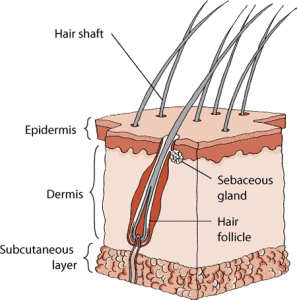Skin Anatomy
Skin. It is the largest organ on the human body. It creates a protective layer against heat, light, the environment, injury and infection. It helps regulate the body’s temperature; stores water, fat and Vitamin D; prevents entry of bacteria; and acts as a sensory organ. On average, an adult has between 18 and 20-square feet of skin, which roughly weighs six pounds.

There are three layers to skin:
Epidermis — This is the outer most layer that sloughs off dead skin cells and acts as a protective barrier against foreign bodies, infections and the sun. The epidermis also contains the cells (melanocytes), which are responsible for skin pigmentation.
Dermis — The middle layer of skin, the dermis houses hair follicles, sebaceous (oil) glands, sweat glands, capillaries (small blood vessels) and lymph vessels. It is held together by a protein called collagen. Sweat glands are part of the body’s cooling system. The dermis also contains touch and pain receptors.
Subcutaneous — This is the deepest layer of skin containing larger blood vessels and nerves. It is made up of a network of collagen and fat cells and plays an important role in the manufacture of Vitamin D, protecting against injury and conserving body heat.
- Acne on face
- Rashes
- Rosacea
- moles
- Etching of skin
- Hair loss
- Hair treatment
- Wrinkles
- Spots on skin
- Pimples
- Cosmetic Dermatologist in pune - January 21, 2023
- Essential Vitamins for Beautiful Skin - July 31, 2015
- Benefits of Turmeric for Skin - July 30, 2015

